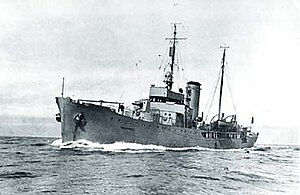HNoMS Fridtjof Nansen (1930)

Fridtjof Nansen at sea
|
|
| History | |
|---|---|
|
|
|
| Name: | Fridtjof Nansen |
| Namesake: | Norwegian explorer Fridtjof Nansen |
| Builder: | Royal Norwegian Naval Yard at Karljohansvern, Horten |
| Yard number: | 118 |
| Launched: | 5 November 1930 |
| Commissioned: | 29 May 1931 |
| Decommissioned: | 8 November 1940 |
| Fate: | Ran aground on an unmarked shallow and sank outside Jan Mayen on 8 November 1940 |
| Service record | |
| Commanders: |
|
| Operations: | |
| General characteristics | |
| Displacement: | 1,275 tons |
| Length: | 72.8 m (238.85 ft) |
| Beam: | 10.5 m (34.45 ft) |
| Draft: | 5.7 m (18.70 ft) |
| Propulsion: |
|
| Speed: | 15 knots (27.78 km/h) |
| Range: | 7,000 nautical miles (12,964.00 km) |
| Complement: | 70 men |
| Armament: |
|
Fridtjof Nansen was the first ship in the Norwegian armed forces to be built specially to perform coast guard and fishery protection duties in the Arctic. She saw service in the Second World War with the Royal Norwegian Navy until she ran aground on an unmarked shallow at Jan Mayen in November 1940.
Fridtjof Nansen was constructed with yard number 118 at the Royal Norwegian Naval Yard at Karljohansvern in Horten. She was launched on 5 November 1930, and command was assumed on 29 May 1931 by Commander Ole A. Blom.
On 21 December 1933 Fridtjof Nansen departed the port of Hammerfest on her way to her patrol areas in eastern Finnmark. While passing through Vestervågen in Måsøy she ran aground and sank the next night. She was raised the next year and taken to Horten for repairs.
At the outbreak of war in Norway with the German invasion on 9 April 1940, Fridtjof Nansen was posted to the Finnmark detachment of the 3rd Naval District covering North Norway. When the German invasion began Fridtjof Nansen was operating from the port of Honningsvåg in Finnmark.
After surviving several air attacks without damage during the Norwegian Campaign Fridtjof Nansen was one of the thirteen Royal Norwegian Navy vessels that made it to the United Kingdom, as she escaped westwards at the dawn of the 10 June 1940 mainland Norwegian capitulation. On 8 June 1940 she took on board in Tromsø Rear Admiral Henry E. Diesen, foreign minister Halvdan Koht and General Carl Gustav Fleischer, in addition to some other refugees. Among those who escaped on Fridtjof Nansen were some 20-25 anti-Nazi German refugees. One of the Germans fleeing with his family on Fridtjof Nansen, was Dadaist painter Kurt Schwitters.
...
Wikipedia
